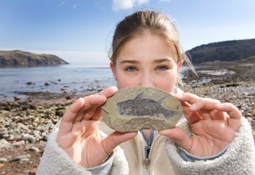
The Scottish Fossil Code, first of its kind in the world, has been launched writes Colin MacFadyen
Geoscientist Online 20 May 2008
In Cromarty on 11 April 2008, on the eve of the Hugh Miller - ‘Local Hero’ event, the Scottish Fossil Code was launched by Michael Russell, the Scottish Government Environment Minister.
Probably the first national code of its kind, the Scottish Fossil Code aims primarily to help conserve the fossil heritage of Scotland. The Nature Conservation (Scotland) Act 2004 included provision for Scottish Natural Heritage to prepare the Code. Produced with assistance from palaeontological researchers, land managers, collectors and others with an interest in Scotland’s fossil heritage, the Code provides advice on best practice in the collection, identification, conservation and storage of fossil specimens found in Scotland. The Code also aims to enhance public interest in the fossil heritage of Scotland and promote this resource for scientific, educational and recreational purposes. It is hoped that following the Code will increase the personal interest and satisfaction that can be gained from forming a fossil collection.